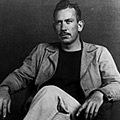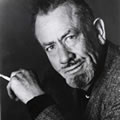Adjectives To Describe Steinbeck's Life

Photo: Sonya Noskowiak,
courtesy Arthur Noskowiak
What makes John Steinbeck and so fascinating? His quirky personality? His unique world view? His powerful understanding of the American spirit? The wide range of his piece of work in fiction, nonfiction, drama and film? Find the homo behind the volume Oprah says might exist the best novel she's ever read!
A shy man. A class act. A visionary. An experimental author. A socially engaged citizen. A "shameless magpie," every bit he described his habit of picking up on the sounds of people's speech, fragments of their stories. Although opinions vary on how to describe the human, John Steinbeck is one of America's nearly dear and honored writers. Described equally "the bard of the people" in a Centennial celebration of his birth that lasted a total year, he gave a phonation to the downtrodden and dispossessed in America. His compassionate portraits of the human condition sell more than 700,000 copies every year, and many of his works are cherished by every generation that discovers them. Equally popular today as he was during his lifetime, well-nigh all of his works are even so in impress.
An Affair in the Salinas Valley
During summers as a male child, Steinbeck worked every bit a hired manus on local ranches. Born February 27, 1902 in Salinas California, he took in the sights, sounds and smells of the valley he called habitation and they fabricated their mark on him. His get-go stories were written every bit a teenager in the house where he was built-in. Thus began John Steinbeck'due south love affair with the valley of his birth: an matter that would accept him from a struggling writer to a Pulitzer Prize-winning author celebrated around the world. Steinbeck spent his youth soaking up the rich agricultural valley that would go the setting of many of his novels and stories.
But Steinbeck's relationship with the town of Salinas was a turbulent one. The farming community provides the groundwork for several of his stories, including East of Eden, but Steinbeck'south writing too alienated the writer from the very people he portrayed so honestly. Following the publication of The Grapes of Wrath in 1939, the people of Salinas valley railed confronting Steinbeck for what they considered to exist a scathing image of their fashion of life. In writing East of Eden more than a decade after, Steinbeck prepare out to pay tribute to Salinas. His goal was to leave a record of the dazzler of his homeland, and the truth of his heritage, for his sons—John IV and Thomas—and generations to come.

Photograph: (c) William Ward Beecher,
courtesy Earth Photos.
Making Ends Encounter While Living a Dream
Steinbeck decided at the age of 14 that he wanted to be a writer. His female parent, Olive, a onetime instructor, fostered his beloved of reading and writing, but eventually lamented his decision to make it a profession. Post-obit graduation from Salinas High School in 1919, Steinbeck attended Stanford University sporadically until 1925, enrolling in creative writing classes but ultimately dropped out without a degree. For the adjacent iv years, he concentrated on writing, living first in New York City and somewhen returning to California. In the beginning, he had a hard time making a go of it. He struggled to notice a publisher, and fifty-fifty after the publication of his first three novels (starting with Loving cup of Golden in 1929), he was still virtually unknown.
Until he became a successful author (with his first budgetary and critical success, Tortilla Flat, published in 1935) he earned a living equally a carpenter, ranch paw, factory laborer, sales clerk, caretaker and reporter, and was also given financial aid by his father in the hope that he would develop his craft. He did. Unfortunately, merely earlier his fame broke, Steinbeck suffered the loss of both parents.
From Best-sellers to Blockbusters
Steinbeck'south most famous novel, The Grapes of Wrath (1939), is a landmark of twentieth-century American literature; it tells the story of Oklahoma migrant workers and California growers in the darkest days of the California depression. The novel won the Pulitzer Prize in 1940 and catapulted Steinbeck into his generation's literary elite. His 30-iv works of fiction and non-fiction (most written during a very prolific period from 1935–1965) are varied in subject area and convey his enthusiasm and curiosity about the world. They are honest. They are real.
Other notable works include Tortilla Apartment, Of Mice and Men, Sea of Cortez, Cannery Row, The Pearl and E of Eden. He considered the terminal his epic—the novel he was born to write. After it was finished, he wrote the majority of his non-fiction, penning the travelogue Travels with Charley, an adaptation of the classic Arthurian legend Morte d'Arthur and a book of essays titled America and Americans.
Steinbeck was as well very prolific in flick. Unlike many writers, he became deeply involved in several adaptations of his works, forging life-long friendship with such directors every bit Elia Kazan, writing a few scripts himself, and spending time helping to rewrite storylines. Of Mice and Men, The Grapes of Wrath, Tortilla Flat, The Pearl, The Red Pony and Due east of Eden were all successfully adjusted for the screen and brought him farther fame and fortune.

Photo: National Steinbeck Center
Pat Hathaway drove
The Myth, The Legend
Steinbeck lived a life of agile observation. He was intensely curious and also intensely private. Many of his closest relationships were strained by his unwavering commitment to his work. Steinbeck's friendship with marine biologist and philosopher Edward F. Ricketts ("Doc," as he is portrayed in a number of Steinbeck's works) was profoundly influential in shaping his views (together they wrote Sea of Cortez in 1941) and the loss of his friend to a train accident in 1948 left him bereft, without the intellectual companion whose friendship he'd long cherished.
Steinbeck married iii times. His kickoff wife Carol was very involved at the beginning of his career; she provided editorial communication, unwavering support and hours of commitment typing his hand-written notes into finished drafts. Gwyn Conger, his second wife, was the mother of his sons Thom and John. In 1949 he met his third wife, Elaine. Steinbeck and Elaine, who were very bonded, remained together for the remainder of his life, spending about of their fourth dimension in New York and Sag Harbor. His later years were spent writing and traveling extensively; he was recognized as ane of America'southward most dearest writers. One of the pinnacles of his career was accepting the Nobel Prize for Literature in 1962, where he paid tribute to the written word and his literary debt to contemporary William Faulkner. John Steinbeck died in New York City on December 20, 1968. Steinbeck's ashes are buried in his family unit plot in Salinas, California.
In 1931, Steinbeck and wife Carol purchased two mallard ducks, "Aqua" and "Vita" to stock the fishpond at their Pacific Grove cottage. The ducks had to be sold afterwards to purchase writing paper for To a God Unknown.
Carol Steinbeck wrote humorous poetry which she published under the name Amnesia Glasscock.
John Steinbeck was left-leaning in his politics: "I am basically, intrinsically and irresistibly a Democrat," he wrote in 1956, later on roofing the national political conventions. He knew FDR and wrote him in 1942 protesting Japanese internment; supported Adlai Stevenson because he loved his writing and speaking; and contributed ideas and passages for speeches to L.B.J. Steinbeck's wife, Elaine, had gone to Academy with Lady Byrd Johnson in Texas.
During World War II, John Steinbeck was a correspondent for the Herald Tribune. His columns were syndicated nationwide, except in Oklahoma, which had yet to forgive him for writing The Grapes of Wrath.
In 1953, a year or and then later on East of Eden was published, Steinbeck suffered the first of several small strokes during which he would trip or become disoriented. He was too treated for anxiety and manic low by psychologist, Gertrudis Brenner, a friend of his literary agent, Elizabeth Otis.
Afterward the assassination of President John F. Kennedy, Jacqueline Kennedy approached Steinbeck to write the official biography of the late president. John and his third wife, Elaine, had been in Warsaw, Poland when President Kennedy was shot.
According to Elaine Steinbeck, John asked her if he could take Charley, her dog, on his trip around America. Worried well-nigh John'south wellness and his being alone on the road, Elaine responded enthusiastically: "That's wonderful. If you go in problem, Charley can get for help. If there's danger, Charley can warn you." John responded: "Elaine, I'chiliad taking Charley, non Lassie."
Years after her husband'due south death, Elaine Steinbeck went into a bookstore in Nippon, asking if they carried copies of The Grapes of Wrath. The owner was puzzled, not recognizing the title. "It's by John Steinbeck," she insisted. "Oh," said the owner, finally understanding her request. "You lot hateful The Aroused Raisins."
Today, most four decades after his death, all of Steinbeck's novels are in impress, and collectively sell a combined total of more than than 700,000 copies a yr.
The National Steinbeck Middle in Salinas has 100,000 visitors per twelvemonth and price $xi million to build.
The Heart for Steinbeck Studies at San Jose State University houses the largest Steinbeck collection in the world and publishes Steinbeck Studies with the Academy of Idaho Press, the but journal focusing on the author.
Viii Americans, including John Steinbeck (1962), have won the Nobel Prize in Literature: Sinclair Lewis (1930); Eugene O'Neill (1936); Pearl Cadet (1938); William Faulkner (1949); Ernest Hemingway (1954); Saul Bellow (1976); and Toni Morrison (1993).
Steinbeck was awarded the Nobel Prize for Literature in 1962 "for his realistic and imaginative writings, combining every bit they do sympathetic humour and bang-up social perception."
After The Grapes of Wrath was published, first lady Eleanor Roosevelt defended the book in her writings and bodacious readers that Steinbeck had not exaggerated the conditions of poverty in the book.
The Grapes of Wrath is listed number 10 on Modern Library's Top 100 Novels of the 20th century, and the picture adaptation ranks number 21 on the American Motion picture Institute's listing of 100 Greatest American Movies.
At Steinbeck's funeral, Henry Fonda—who starred in the film version of The Grapes of Wrath—read poems by Petrarch, Tennyson and Robert Louis Stevenson.
The Grapes of Wrath has been translated into at least 43 languages.
Copies of The Grapes of Wrath were burned on the adjourn of the Salinas Public Library and on the sidewalk in Bakersfield California.
Steinbeck's Of Mice and Men was the about oft banned books in the 1990s. The original working title for Of Mice and Men was "Something that Happened," to reflect the theme that that sometimes things happen that simply evidence the style life is.
Left lone ane night, Steinbeck's new puppy, Toby, ate the original manuscript of Of Mice and Men after Steinbeck was near half finished with the novel. "I was pretty mad, but the poor little swain may have been acting critically," he wrote his agent.
Early on in his career, Steinbeck burned the manuscripts of between sixty and seventy short stories that he had written. "I am writing and so well now that I don't desire the old stories effectually anymore. They are terrible reminders of where I've come from."
Steinbeck's first novel was revised and published following a snowbound winter as the caretaker of a cabin in Lake Tahoe. During his early career, his manuscript for Tortilla Flat was rejected past numerous publishers. He lost his original manuscript for a novel he later recreated: The Cherry-red Pony, and the rewritten version differed from the i he'd lost by only vii words. Steinbeck "wrote" in his mind earlier committing words to paper; his manuscripts have almost no changes.
Adjectives To Describe Steinbeck's Life,
Source: https://www.oprah.com/oprahsbookclub/john-steinbecks-biography/all
Posted by: matthewkindrem.blogspot.com


0 Response to "Adjectives To Describe Steinbeck's Life"
Post a Comment